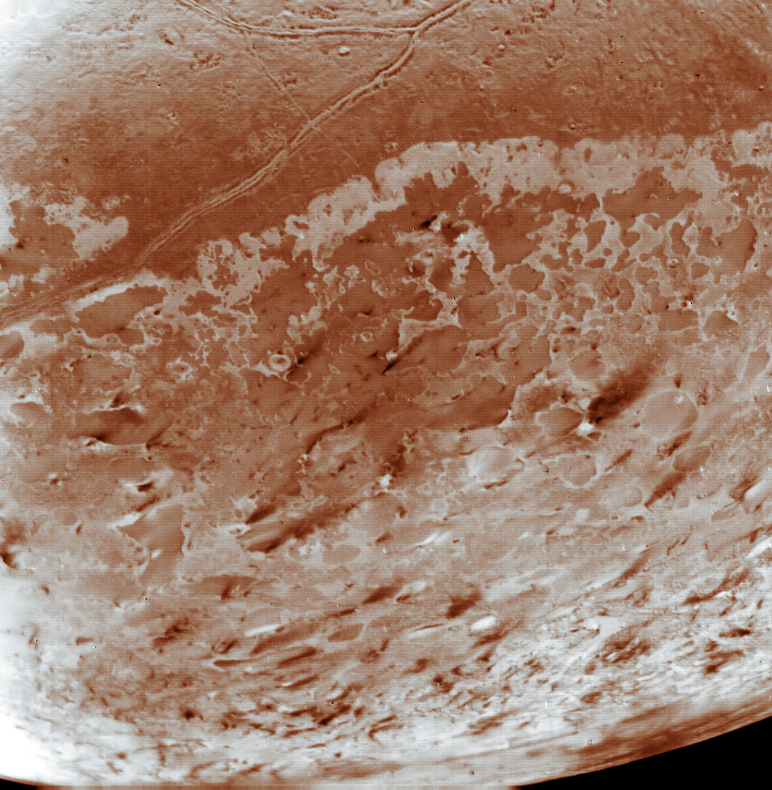
Contents
The Finding and research of Triton
Facts about Triton
Views of Triton
-An introduction to the moon Triton and its geysers-
-Computer Methods internet project-

Contents
The Finding and research of Triton
Facts about Triton
Views of Triton
![]()
The Finding and research of Triton
The moon Triton was discovered by the British astronomer William Lassell on 10th October 1846 scarcely a month after Neptune was found. While was Lassell observing the newly discovered planet he was attempting to confirm his observation, made just the previous week, that
Neptune had a ring. But this time he discovered that Neptune had a satellite as well. Lassell soon proved the ring was product of his new telescope's distortion, but the satellite Triton remained. Ironically, Voyager also confirmed the existence of complete thin rings around Neptune - but these would have been quite invisible to Lassell!Triton was first visited by the Voyager space probe and in the wake of the successful Uranus encounter, Voyager was redirected toward Neptune, last objective of its multi-planet mission. The probe reached the outer giant planet on August 25, 1989.
Facts about Triton
The Ice Geysers of Triton
From Earth-based spectrometric analysis, Triton was thought to be covered by nitrogen ice with some methane. Voyager confirmed the prediction, revealing a complex landscape varnished with nitrogen ice features and minor amounts of methane and carbon monoxide ice. At over 4 billion km from the Sun, the faint light reaching Triton still managed to set off photochemical reactions with the ice, transforming methane into colourful polymers and giving Triton its pastel blend of blue, yellow, and peach tints, under a haze of wind-blown gas. This can be seen on many of the photos in the report, the best being the title photo.
The small number and subdued appearance of impact craters on Triton indicated a substantial level of internal activity, and indeed a multitude of small vents were spotted on the Voyager imagery, as well as smooth plains assumed to be outpourings of ices. Like the lava's of Earth in such places as Hawaii. Four large depressions up to 200km across showed up in the smooth plains, looking like icy calderas, with pits and flows concentrated in the centre.
Older terrain on Triton appeared pock-marked by a dense array of subcircular cells, 5 to 25km in diameter, traversed by sinuous ridges. Giving Triton's surface the appearance of a melon skin, this so called cantaloup terrain covers roughly a third of Triton's observed surface, and is reminiscent of salt diapir provinces on Earth. One explanation is that the crustal ices of Triton were heated at some stage in the moon's history (perhaps when Triton was captured by Neptune) , and warm ices of various compositions ( nitrogen, hydrated ammonia, methane, carbon monoxide) erupted onto the surface. Upon cooling, some of the deeper ices ended up more buoyant than the overlying ones, and rose through them as pancake- shaped diapirs, to create the cellular patchwork at the surface.
While Voyager was passing Triton it tool a dozen images of the moon from a variety of angles, and overlapping images were paired to create stereoscopic views of the surface. While pairing-up images, Voyager team member Larry Soderblom discovered to his great surprise that two horizontal plumes stood out above the surface, stretching westward from what looked like erupting, dark columns 8km high. Geysers on Triton! Comparing images taken 45 minutes apart, wind-blown plumes showed a dynamic growth, doubling in length from 80 to over 150km. Near the easternmost event, at least one other diffuse plume was located, probably the subdued trace of an eruption that had only recently shut down. By combing and contrast-stretching the rest of the imagery, another half-dozen veils were highlighted above the moon's limb.
Geysers thus appear to be a widespread occurrence on Triton. Regarding the eruption process, a crucial clue was provided by the geographical distribution of the plumes and streaks. All were bunched in the austral latitudes between 40
° S and 60° S. This the region pointing towards the distant Sun. Triton's geysers therefore appear to be solar driven, although temperatures at the surface are so low (around 38 K) that even nitrogen ice would not be expected to melt under normal conditions. Imaginative heating mechanisms were proposed, including greenhouse effects occurring in the translucent ices. Indeed, Triton might be the world that we encounter where eruptions are driven by solar thermal heating!Solar heating on Triton would work along the same principles as our solar-heating panels on Earth: in these, a transparent surface (usually glass) covers a layer of air or water, coated at the bottom with a dark substrate, which radiates the energy back at longer wavelengths (infrared). But since the glass cover is opaque to infrared the energy stays trapped within the panel, raising the heat of the fluid (air or water).
Triton's surface could likewise be a natural solar panel: a superficial layer of frozen, transparent nitrogen (a couple of meters thick) would act as the transparent cover and medium: visible solar radiation penetrating the surface would be converted to infrared by dark, carbon-like impurities in the ice ( playing the role of the dark substrate) and the resulting infrared radiation would remain trapped. With a temperature rise of only a few degrees, a fraction of the nitrogen ice would then begin to vaporise and circulate through fractures in the "panel", until reaching a vent and decompressing to blow out as a plume.
The geyser eruptions could have carried darker materials from the crust. The light regions probably consist of layers of nitrogen.
While scientists are unsure of the details of Triton's history, icy volcanism is undoubtedly an important ingredient.
To understand what is happening on Triton, one must ask, "How cold is cold? How soft is soft? How young is young?" Water ice, whose melting point is 0°C (32°F), deforms more easily and rapidly on Earth than rock does, but becomes almost as rigid as rock at the extremely low temperatures found on Triton, more than 4 billion kilometres from the Sun. Most of the geologic structures on Triton's surface are likely formed of water ice, because nitrogen and methane ice are too soft to support much of their own weight.
On the other hand, nitrogen and methane, which form a thin veneer on Triton, turn from ice to gas at less than 100 degrees above absolute zero. Most of the geologically recent eruptions at those low cryogenic temperatures are due to the nitrogen and methane on Triton.
Evidence that such eruptions occur was found in Voyager images of several geyser-like volcanic vents that were apparently spewing nitrogen gas laced with extremely fine, dark particles. The particles are carried to altitudes of 2 to 8 kilometres (1 to 5 miles) and then blown downwind before being deposited on Triton's surface.
(Taken and abridged from Volcanoes of the Solar System by Charles Frankel a non internet source.)
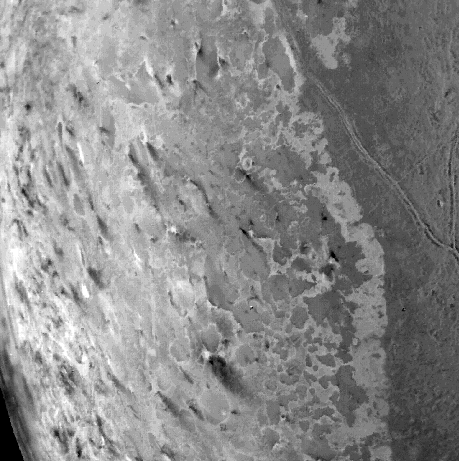
The photograph above shows the ice geysers very clearly. The plumes can be seen stretching over the surface of the moon.
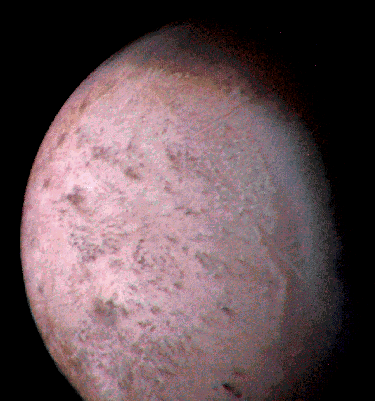
This is a description of the first photo in the project, not the one above.
The large south polar cap at the bottom of the image is highly reflective and slightly pink in colour; it might consist of a slowly evaporating layer of nitrogen ice deposited during the previous winter. From the ragged edge of the polar cap northward, the satellite's face is generally darker and redder in colour. This colouring may be produced by the action of ultraviolet light and magnetospheric radiation upon methane in the atmosphere and surface. Running across this darker region, approximately parallel to the edge of the polar cap, is a band of brighter white material that is almost bluish in colour. The underlying topography in this bright band is similar; however, to that in the darker, redder regions surrounding it.The photo above is of the side of Triton and shows the pink colour that is described in the report.
Surface of Triton
The picture was taken from a distance of 40,000 kilometres (25,000 miles), the frame is about 220 kilometres (140 miles) across and shows details as small as 750 meters (0.5 miles). Most of the area is covered by a peculiar landscape of roughly circular depressions separated by rugged ridges. This type of terrain, which covers large tracts of Triton's northern hemisphere, is unlike anything seen elsewhere in the solar system. The depressions are probably not impact craters: They are too similar in size and too regularly spaced. Their origin is still unknown, but may involve local melting and collapse of the icy surface. A conspicuous set of grooves and ridges cuts across the landscape, indicating fracturing and deformation of Triton's surface. The rarity of impact craters suggests a young surface by solar system standards, probably less than a few billion years old.
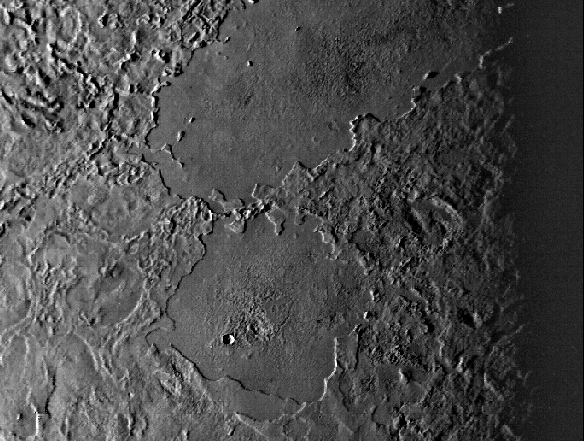
Dark Areas on Triton
Triton's limb cuts obliquely across the middle of the image. The field of view is about 1,000 km (600 miles) across. Three irregular dark areas, surrounded by brighter material, dominate the image. Low-lying material with intermediate albedo occupies the central area, and fresh craters occur along the right margin. Sub-parallel alignment of linear patches of dark material shown in the lower and left part of the image suggests that the patches are structurally controlled.
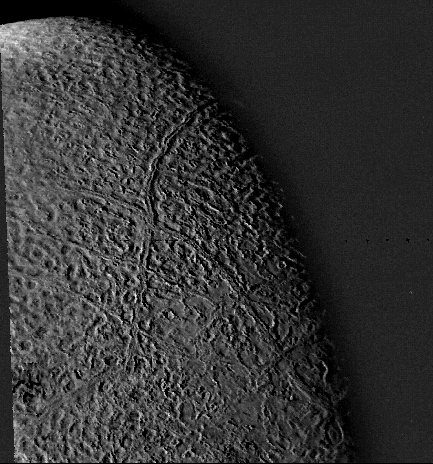

Acknowledgements
All photo's and scientific explanations courtesy of NASA/JPL/ Calvin J. Hamilton/Cambridge Press
All photo's taken by Voyager.
Ice volcano explanation from Volcanoes of the Solar System, Charles Frankel, Cambridge Press.
Photo websites are:
Voyager2:http://nssdc.gsfc.nasa.gov/imgcat/html/mission_page/NS_Voyager_2_page1.html
and:http://somenosuke.edu.ipa.go.jp/mirrors/togane-ghs/TNP/nineplanets/pxnep.html#TRITON
-George Eves, First Year Geology Student-
-ge6691@bris.ac.uk